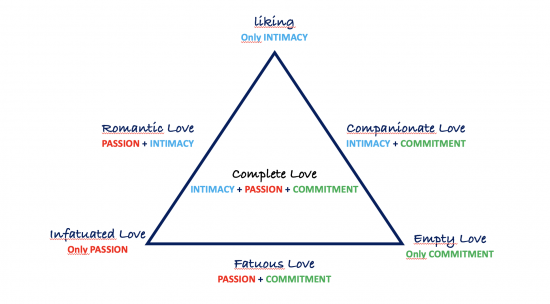 Sternberg’s Triangular Theory of Love
Sternberg’s Triangular Theory of LoveIn 1988, psychologist Robert Sternberg, published the Triangular Theory of Love, according to which love, or rather different forms of love, are articulated through three fundamental elements -intimacy, passion and commitment– that we can see placed at the triangle’s vertices.
According to Sternberg, intimacy has to do with emotional bonding, closeness and connection, passion with the drives that lead to romance, physical and sexual attraction, while commitment has to do in the short term with the decision to love a specific person, whereas in the long term with a commitment to keep that love alive.
The three components of love give life to eight possible types of love. Non-Love is the absence of the 3 elements. Liking is the result of intimacy alone, in the absence of passion and commitment, Infatuation is only passion, and Empty Love is only Commitment. Romantic Love derives from the combination of intimacy and passion, Companionate-Love from Intimacy and Commitment, Fatuous Love from passion and commitment, while Complete Love is the result of the combination of all three elements.
According to Sternberg, love doesn’t involve just one triangle, but rather involves several triangles. For example, our ideal love triangle doesn’t necessarily coincide with the kind of love we have in our relationship, as it is possible to experience different types of Love, depending on the relationship we are in.
What type of Love do you think you have at the moment? Do you feel like you are missing one or more elements?






